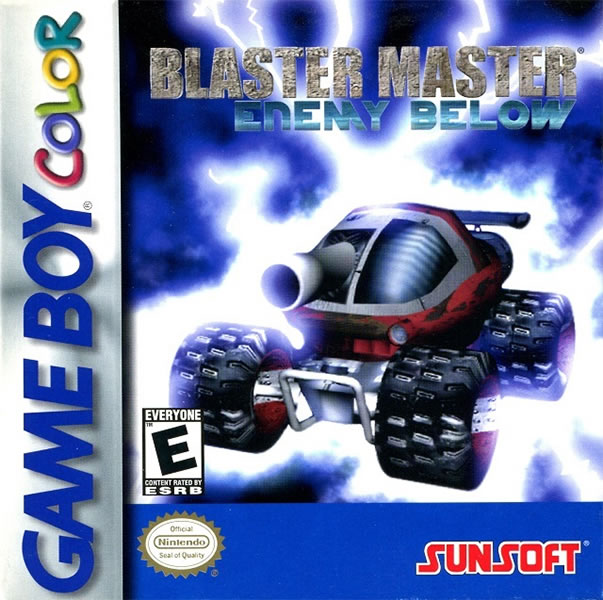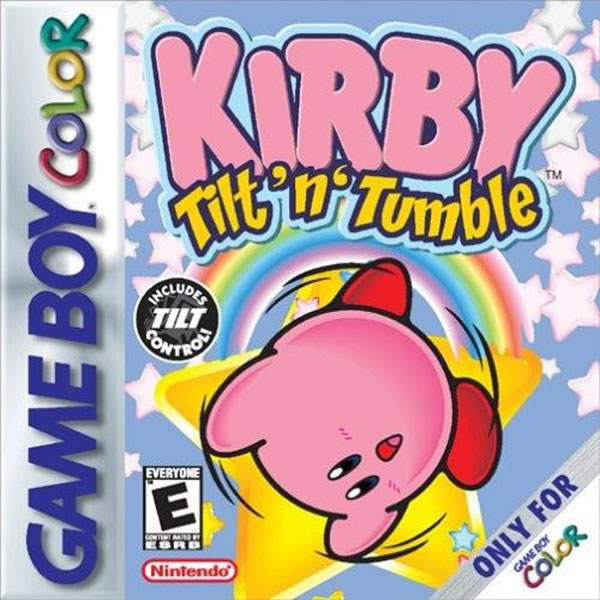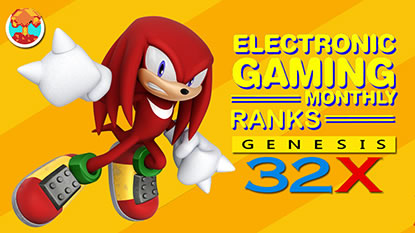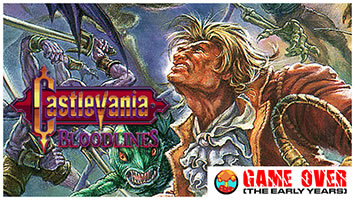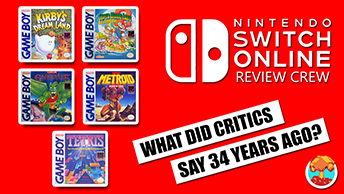- CLASSIC MAGAZINES
- REVIEW CREW
A show recapping what critics thought back
when classic games first came out! - NEXT GENERATION'S BEST & WORST
From the worst 1-star reviews to the best
5-stars can offer, this is Next Generation! - NINTENDO POWER (ARCHIVE)
Experience a variety of shows looking at the
often baffling history of Nintendo Power! - MAGAZINE RETROSPECTIVE
We're looking at the absolutely true history of
some of the most iconic game magazines ever! - SUPER PLAY'S TOP 600
The longest and most ambitious Super NES
countdown on the internet! - THEY SAID WHAT?
Debunking predictions and gossip found
in classic video game magazines! - NEXT GENERATION UNCOVERED
Cyril is back in this spin-off series, featuring the
cover critic review the art of Next Generation! - HARDCORE GAMER MAGAZING (PDF ISSUES)
Download all 36 issues of Hardcore Gamer
Magazine and relive the fun in PDF form!
- REVIEW CREW
- ELECTRONIC GAMING MONTHLY
- ELECTRONIC GAMING MONTHLY RANKS
From Mario to Sonic to Street Fighter, EGM
ranks classic game franchises and consoles! - ELECTRONIC GAMING MONTHLY BEST & WORST
Counting down EGM’s best and worst reviews
going year by year, from 1989 – 2009! - ELECTRONIC GAMING BEST & WORST AWARDS
11-part video series chronicling the ups and
downs of EGM’s Best & Worst Awards!
- ELECTRONIC GAMING MONTHLY RANKS
- GAME HISTORY
- GAME OVER: STORY BREAKDOWNS
Long-running series breaking down game
stories and analyzing their endings! - A BRIEF HISTORY OF GAMING w/ [NAME HERE]
Real history presented in a fun and pithy
format from a variety of game historians! - THE BLACK SHEEP
A series looking back at the black sheep
entries in popular game franchises! - INSTANT EXPERT
Everything you could possibly want to know
about a wide variety of gaming topics! - FREEZE FRAME
When something familiar happens in the games
industry, we're there to take a picture! - I'VE GOT YOUR NUMBER
Learn real video game history through a series
of number-themed episodes, starting at zero! - GREAT MOMENTS IN BAD ACTING
A joyous celebration of some of gaming's
absolute worst voice acting!
- GAME OVER: STORY BREAKDOWNS
- POPULAR SHOWS
- DG NEWS w/ LORNE RISELEY
Newsman Lorne Riseley hosts a regular
series looking at the hottest gaming news! - REVIEW REWIND
Cyril replays a game he reviewed 10+ years
ago to see if he got it right or wrong! - ON-RUNNING FEUDS
Defunct Games' longest-running show, with
editorials, observations and other fun oddities! - DEFUNCT GAMES QUIZ (ARCHIVE)
From online quizzes to game shows, we're
putting your video game knowledge to the test!- QUIZ: ONLINE PASS
Take a weekly quiz to see how well you know
the news and current gaming events! - QUIZ: KNOW THE GAME
One-on-one quiz show where contestants
find out if they actually know classic games! - QUIZ: THE LEADERBOARD
Can you guess the game based on the classic
review? Find out with The Leaderboard!
- QUIZ: ONLINE PASS
- DEFUNCT GAMES VS.
Cyril and the Defunct Games staff isn't afraid
to choose their favorite games and more! - CYRIL READS WORLDS OF POWER
Defunct Games recreates classic game
novelizations through the audio book format!
- DG NEWS w/ LORNE RISELEY
- COMEDY
- GAME EXPECTANCY
How long will your favorite hero live? We crunch
the numbers in this series about dying! - VIDEO GAME ADVICE
Famous game characters answer real personal
advice questions with a humorous slant! - FAKE GAMES: GUERILLA SCRAPBOOK
A long-running series about fake games and
the people who love them (covers included)! - WORST GAME EVER
A contest that attempts to create the worst
video game ever made, complete with covers! - LEVEL 1 STORIES
Literature based on the first stages of some
of your favorite classic video games! - THE COVER CRITIC
One of Defunct Games' earliest shows, Cover
Critic digs up some of the worst box art ever! - COMMERCIAL BREAK
Take a trip through some of the best and
worst video game advertisements of all time! - COMIC BOOK MODS
You've never seen comics like this before.
A curious mix of rewritten video game comics!
- GAME EXPECTANCY
- SERIES ARCHIVE
- NINTENDO SWITCH ONLINE ARCHIVE
A regularly-updated list of every Nintendo
Switch Online release, plus links to review! - PLAYSTATION PLUS CLASSIC ARCHIVE
A comprehensive list of every PlayStation
Plus classic release, including links! - RETRO-BIT PUBLISHING ARCHIVE
A regularly-updated list of every Retro-Bit
game released! - REVIEW MARATHONS w/ ADAM WALLACE
Join critic Adam Wallace as he takes us on a
classic review marathon with different themes!- DEFUNCT GAMES GOLF CLUB
Adam Wallace takes to the links to slice his way
through 72 classic golf game reviews! - 007 IN PIXELS
Adam Wallace takes on the world's greatest spy
as he reviews 15 weeks of James Bond games! - A SALUTE TO VAMPIRES
Adam Wallace is sinking his teeth into a series
covering Castlevania, BloodRayne and more! - CAPCOM'S CURSE
Adam Wallace is celebrating 13 days of Halloween
with a line-up of Capcom's scariest games! - THE FALL OF SUPERMAN
Adam Wallace is a man of steel for playing
some of the absolute worst Superman games! - THE 31 GAMES OF HALLOWEEN
Adam Wallace spends every day of October afraid
as he reviews some of the scariest games ever! - 12 WEEKS OF STAR TREK
Adam Wallace boldly goes where no critic has
gone before in this Star Trek marathon!
- DEFUNCT GAMES GOLF CLUB
- DAYS OF CHRISTMAS (ARCHIVE)
Annual holiday series with themed-episodes
that date all the way back to 2001!- 2015: 30 Ridiculous Retro Rumors
- 2014: 29 Magazines of Christmas
- 2013: 29 Questionable Power-Ups of Christmas
- 2012: 34 Theme Songs of Christmas
- 2011: 32 Game Endings of Christmas
- 2010: 31 Bonus Levels of Christmas
- 2009: 30 Genres of Christmas
- 2008: 29 Controls of Christmas
- 2007: 34 Cliches of Christmas
- 2006: 33 Consoles of Christmas
- 2005: 32 Articles of Christmas
- 2004: 31 Websites of Christmas
- 2003: 29 Issues of Christmas
- 2002: 28 Years of Christmas
- 2001: 33 Days of Christmas
- NINTENDO SWITCH ONLINE ARCHIVE
- REVIEW ARCHIVE
- FULL ARCHIVE
Nintendo Switch Online: 1990s Critics Review Kirby Tilt ‘N' Tumble, Harvest Moon & More
The game you're looking at right now is Kirby Tilt ‘N' Tumble, and it's just one of the games added to the Nintendo Switch Online service this week. That's right, Nintendo surprised everybody with an early-week drop of some classic 8- and 16-bit games, including Blaster Maser: Enemy Below, Harvest Moon and Mystery Tower, a game that had previously never been released outside of Japan. That's really cool, but are any of these games actually worth playing? To answer that question, I decided to flip through the pages of Electronic Gaming Monthly, Nintendo Power, Computer & Video Games and more classic magazines to see what the critics said back when these games first came out. Well, all of them except for Mystery Tower, with understandably was not reviewed by any English-language critics back in 1986. So, go and grab a shovel and overalls, because this is another farm-friendly episode of the Nintendo Switch Online Review Crew.
When Blaster Master was first released on the Nintendo Entertainment System 35 years ago, it was a breath of fresh air. In a world where most games were either side-scrolling platformers or overhead shooters, Sunsoft's 1988 action game dared to be both. And it worked, with both critics and fans falling in love with Jason and his versatile tank, Sophia the 3rd. Unfortunately, the subsequent sequel and Game Boy spin-off were not met with the same fanfare, resulting in Sunsoft scrapping the franchise for the better part of a decade. Finally, in the year 2000, Jason and Sophia returned in the Game Boy Color game, Blaster Master: Enemy Below. This brought back the multiple perspectives and epic boss fights that made the first game so popular, all in the hopes that it could ride the wave of nostalgia that was hitting Nintendo's colorful handheld. It was definitely nostalgic, but was that enough for the critics?
In short, the answer was no. Like a lot of Game Boy Color games released at the turn of the millennium, most magazines completely ignored this game. In fact, I could only find two magazines that bothered reviewing it, and neither presented a glowing picture of the reboot. Let's start with Nintendo Power, which gave it a 7.6 out of 10 and called it “solid platform action” with color that is “fantastic on GBC.” Nate sums it up this way: “If you don't like it on the NES, you won't like it now. But I, for one, can't get enough of the NES-to-Game Boy Color migration.” Jennifer was not impressed, falling asleep during her review: “I would try to comment, but (yawn) I keep falling asl...zzz.” Not exactly a ringing endorsement.
Across the pond, Computer & Video Games sided more with Jennifer than Nate. They gave it a 2 out of 5 and concluded: “Fans of the series will lap up Blaster as a chunk of nostalgia. Anyone new to it though, will most likely wonder what all the fuss is about. There are better platform shooters available for your coinage and, unless you're a fan of the previous games, you're likely to be seriously disappointed.” As a fan of the original Blaster Master on NES, I do have nostalgia for Enemy Below. That said, this game is definitely not for everybody.
With dozens of sequels, updates, re-releases and spin-offs, getting into the Harvest Moon series can be a bit daunting. Where do you even start? Well, perhaps you begin with the 1997 Super NES game that started it all. Harvest Moon is a bright and colorful farming simulator where you tend to the crops and feed the animals, all while foraging for items, exploring your surroundings and getting to know the townspeople. It's a simple concept with a lot of fun activities that prove to be extremely relaxing, which is why this franchise has endured for so many decades. Did the critics see the series potential from this first game?
When it comes to Electronic Gaming Monthly, the answer to that question is definitely “yes.” Earning an average score of 8.1 out of 10, the review crew was largely impressed with this unusual role-playing game. Dan summed it up this way: “Sim Farm meets Zelda? Perhaps, but Harvest Moon wins my vote for one of the most refreshing and original concepts to come out in quite a while.” Sushi-X called it a “sleeper hit [...] with an off-beat quest surrounded by a familiar interface. The farm quest will turn off skeptical users, but once you give the game a try, you'll quickly become immersed in a true adventure that is hard to break away from.”
Nintendo Power wasn't nearly as sold on Harvest Moon as EGM, giving it a score of 3.7 out of 5. They said that “Harvest Moon may sound a lot like PC simulations like Maxis's SimFarm, but the RPG elements really add something. This is not an economic sim, but rather a race against time, the weather, your own learning curve and events.” They liked the “involving, task-oriented play and the fun hidden stuff,” but did complain that it wasn't for action fans. That's right, their biggest complaint is that a farming simulator isn't an exciting action game. That's like saying that Street Fighter II is bad because Final Fantasy fans might not like fighting games. Good grief.
Having mastered the art of making 2D platformers, Nintendo found itself looking for unique ways to shake up the formula and bring some freshness to their aging franchises. That brings us to the 2001 game Kirby Tilt ‘N' Tumble, an overhead action game that used the cartridge's built-in accelerometers to move Kirby around the labyrinthine levels. This meant that you would need to physically tilt the system in order to move our pink hero around like a marble, something that proved to be both simultaneously fun and frustrating.
The reviews were mostly positive for Kirby Tilt ‘N' Tumble, though a lot of the critics felt like it was more of a gimmick than a good idea. Electronic Gaming Monthly ended up giving the game an average score of 6.2 out of 10, with Chris explaining that “it would've been better if there was an option to play with the control pad. Its biggest problem is the tilt technology. You need to have the Game Boy under direct light to see what you're doing, but you have to tilt it for control, making it nearly impossible to play unless you're in an area flooded with light.” Jeanne liked the game even less, elaborating on the problems: “See, the point is now to play the game by tilting your Game Boy Color ‘every which way,' right? Well, what if tilting your GBC means the screen gets lost in shadow and you can't see what the heck Kirby's doing? Try rolling Kirby straight down a narrow platform, Marble Madness-style, without seeing where he's going to end up. You'll soon grow accustomed to hearing Kirby's screams as he fades into the void. Unless you have patience, night vision or an undying adoration for Kirby, let a friend buy the game and just borrow it for those long road trips.”
As you might expect, the critics at Nintendo Power liked it a lot more than Electronic Gaming Monthly. Giving it an average score of 4 out of 5, Drew said that “Kirby's innovative motion control and well-designed levels are wonders to behold, but you'll have difficulty beholding them without a perfectly positioned light source.” Jenni explained that “Kirby Tilt ‘N' Tumble is a refreshingly different way to approach handheld gaming.” The only pushback you saw was from Scott, who argued that “there's a reason video games use controllers.”
Believe it or not, the highest score came from Game Informer, who didn't have a problem at all with the weird motion controls: “Kirby's Tilt ‘N' Tumble's brilliant gyroscopic control offers jaded GBC owners something genuinely new. This game easily could have been a terrible mess, but the developers pull this experiment off with aplomb. The control will hook you, but the addictive gameplay will keep you coming back for more.” They gave it an average score of 8.7 out of 10. Here's hoping the game is easier to play on the Switch than the Game Boy Color.
| Publication | Scores |
|---|---|
| Nintendo Power | 7.6/10 |
| Computer & Video Games | 2/5 |
| AVERAGE SCORE | 58% |
In short, the answer was no. Like a lot of Game Boy Color games released at the turn of the millennium, most magazines completely ignored this game. In fact, I could only find two magazines that bothered reviewing it, and neither presented a glowing picture of the reboot. Let's start with Nintendo Power, which gave it a 7.6 out of 10 and called it “solid platform action” with color that is “fantastic on GBC.” Nate sums it up this way: “If you don't like it on the NES, you won't like it now. But I, for one, can't get enough of the NES-to-Game Boy Color migration.” Jennifer was not impressed, falling asleep during her review: “I would try to comment, but (yawn) I keep falling asl...zzz.” Not exactly a ringing endorsement.
Across the pond, Computer & Video Games sided more with Jennifer than Nate. They gave it a 2 out of 5 and concluded: “Fans of the series will lap up Blaster as a chunk of nostalgia. Anyone new to it though, will most likely wonder what all the fuss is about. There are better platform shooters available for your coinage and, unless you're a fan of the previous games, you're likely to be seriously disappointed.” As a fan of the original Blaster Master on NES, I do have nostalgia for Enemy Below. That said, this game is definitely not for everybody.
| Publication | Scores |
|---|---|
| Electronic Gaming Monthly | 8.1/10 |
| Nintendo Power | 3.7/5 |
| AVERAGE SCORE | 78% |
When it comes to Electronic Gaming Monthly, the answer to that question is definitely “yes.” Earning an average score of 8.1 out of 10, the review crew was largely impressed with this unusual role-playing game. Dan summed it up this way: “Sim Farm meets Zelda? Perhaps, but Harvest Moon wins my vote for one of the most refreshing and original concepts to come out in quite a while.” Sushi-X called it a “sleeper hit [...] with an off-beat quest surrounded by a familiar interface. The farm quest will turn off skeptical users, but once you give the game a try, you'll quickly become immersed in a true adventure that is hard to break away from.”
Nintendo Power wasn't nearly as sold on Harvest Moon as EGM, giving it a score of 3.7 out of 5. They said that “Harvest Moon may sound a lot like PC simulations like Maxis's SimFarm, but the RPG elements really add something. This is not an economic sim, but rather a race against time, the weather, your own learning curve and events.” They liked the “involving, task-oriented play and the fun hidden stuff,” but did complain that it wasn't for action fans. That's right, their biggest complaint is that a farming simulator isn't an exciting action game. That's like saying that Street Fighter II is bad because Final Fantasy fans might not like fighting games. Good grief.
| Publication | Scores |
|---|---|
| Game Informer | 8.7/10 |
| Nintendo Power | 4/5 |
| Electronic Gaming Monthly | 6.2/10 |
| AVERAGE SCORE | 76% |
The reviews were mostly positive for Kirby Tilt ‘N' Tumble, though a lot of the critics felt like it was more of a gimmick than a good idea. Electronic Gaming Monthly ended up giving the game an average score of 6.2 out of 10, with Chris explaining that “it would've been better if there was an option to play with the control pad. Its biggest problem is the tilt technology. You need to have the Game Boy under direct light to see what you're doing, but you have to tilt it for control, making it nearly impossible to play unless you're in an area flooded with light.” Jeanne liked the game even less, elaborating on the problems: “See, the point is now to play the game by tilting your Game Boy Color ‘every which way,' right? Well, what if tilting your GBC means the screen gets lost in shadow and you can't see what the heck Kirby's doing? Try rolling Kirby straight down a narrow platform, Marble Madness-style, without seeing where he's going to end up. You'll soon grow accustomed to hearing Kirby's screams as he fades into the void. Unless you have patience, night vision or an undying adoration for Kirby, let a friend buy the game and just borrow it for those long road trips.”
As you might expect, the critics at Nintendo Power liked it a lot more than Electronic Gaming Monthly. Giving it an average score of 4 out of 5, Drew said that “Kirby's innovative motion control and well-designed levels are wonders to behold, but you'll have difficulty beholding them without a perfectly positioned light source.” Jenni explained that “Kirby Tilt ‘N' Tumble is a refreshingly different way to approach handheld gaming.” The only pushback you saw was from Scott, who argued that “there's a reason video games use controllers.”
Believe it or not, the highest score came from Game Informer, who didn't have a problem at all with the weird motion controls: “Kirby's Tilt ‘N' Tumble's brilliant gyroscopic control offers jaded GBC owners something genuinely new. This game easily could have been a terrible mess, but the developers pull this experiment off with aplomb. The control will hook you, but the addictive gameplay will keep you coming back for more.” They gave it an average score of 8.7 out of 10. Here's hoping the game is easier to play on the Switch than the Game Boy Color.
HOME |
CONTACT |
NOW HIRING |
WHAT IS DEFUNCT GAMES? |
NINTENDO SWITCH ONLINE |
RETRO-BIT PUBLISHING
Retro-Bit |
Switch Planet |
The Halcyon Show |
Same Name, Different Game |
Dragnix |
Press the Buttons
Game Zone Online | Hardcore Gamer | The Dreamcast Junkyard | Video Game Blogger
Dr Strife | Games For Lunch | Mondo Cool Cast | Boxed Pixels | Sega CD Universe | Gaming Trend
Game Zone Online | Hardcore Gamer | The Dreamcast Junkyard | Video Game Blogger
Dr Strife | Games For Lunch | Mondo Cool Cast | Boxed Pixels | Sega CD Universe | Gaming Trend
Copyright © 2001-2025 Defunct Games
All rights reserved. All trademarks are properties of their respective owners.
All rights reserved. All trademarks are properties of their respective owners.







